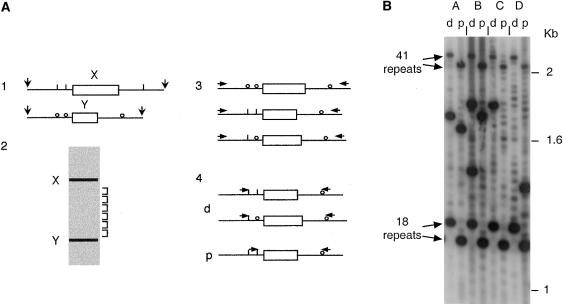Figure 2.
Detection of CEB1 sperm mutants associated with flanking-marker exchange. A, Schematic representation of the size-enrichment and small-pool PCR strategy. 1, Sperm DNA from a man multiply heterozygous for SNPs flanking CEB1, digested with restriction enzymes releasing fragments containing both the SNPs and the CEB1 minisatellite. 2, Size fractionation of digested DNA. The DNA was electrophoresed; and fractions were collected depleted in progenitor alleles X and Y and, therefore, enriched in CEB1 mutant molecules with abnormal array length. 3, Pooled fractions containing mutant molecules, whether recombinant or not, amplified with distal universal primers. 4, Preamplified mutants subjected to allele-specific PCR, in repulsion phase with various combinations of allele specific-primers, to selectively detect any mutants associated with distal (d) or proximal (p) marker exchange. B, Example of detection of sperm mutants associated with flanking-marker exchange. Batches (A–D) of preamplified sperm mutants with sizes intermediate between the 18- and 41-repeat progenitor alleles of individual A were screened by allele-specific PCR for distal (−72G/+384G; lanes d) and more proximal (−4A/+384G; lanes p) flanking exchanges. Low-level mispriming from the wrong allele allows the progenitor alleles and nonexchanged mutants in each batch to be detected. True exchange mutants show much stronger hybridization signals. Two mutants show exchange of both 5′ markers (batch A and the larger mutant in batch B), two show distal but not proximal exchange (batch C and the smaller mutant in batch B), and one shows proximal but not distal exchange (batch D).

